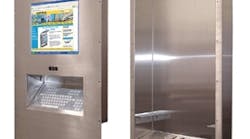For years, one of the most costly elements of pharmaceutical manufacturing has been the documentation necessary to meet the stringent requirements of the U.S. Food and Drug Administration (FDA). In 1997, the FDA released requirements that enabled pharmaceutical manufacturers to move to more efficient digital information management. The regulation is referred to as 21 CFR Part 11, and specifies that, "where electronic signatures and their associated electronic records meet the requirements of this part, the agency will consider the electronic signatures to be equivalent to full hand-written signatures, initials and other general signings as required by agency regulations."
Opportunity and Challenge
Suddenly, manufacturers were faced with both a challenge and an opportunity. The opportunity, of course, was to get out from under the cost and physical limitations of paper handling and move to electronic record keeping. The challenge was to find hardware, software and information management systems that would survive the move down to the plant floor.
The transition for software and information management systems proved less challenging than what was in store for the hardware. Many prominent software vendors were very quickly able to create new versions of their products that were compliant with 21 CFR Part 11. Several vendors also produced hand-held datatakers, based on popular PDA technology to aid compliance.
Regardless, it is still remains difficult to obtain and implement a fully featured HMI operator station designed to perform under conditions of asepsis, a critical necessity for maintaining sanitary and quality control on the pharmaceuticals manufacturing plant floor. A pharmaceutical controls engineer just can't go down to the big box store and pick up a PC and display.
Beyond the Control Room
Taking the computers out of the control room and moving them onto the floor requires special handling. Even a standard "industrially-hardened" PC won't work, because most are designed for rack mounting and have exposed vents and fans. In aseptic processing plants (food, beverage and pharmaceutical applications), washdowns with high-pressure hoses, oftentimes paired with caustic cleaning solutions and hot water are common. A standard industrial PC was never designed for duty in this kind of environment. To protect the PC, not only does it have to placed in an enclosure, but the enclosure must be able to withstand powerful fluid sprays, and be designed to eliminate recesses and other features that might allow moisture to collect and bacterial contamination to grow.
It is also important that suppliers provide for quick replacement in the event of failure, since aseptic production lines are generally critical performance areas. Modularizing the design with an integrated keyboard/pointing device, touch screen and waterproof speaker are essential. Many of these devices are capable of operating on either AC line voltage or DC power.
The typical configuration in a plant floor location is to mount the computer housing on a pedestal, but sometimes there's simply is not room for this kind of station. Some production areas do not even have space for a wall-mounted unit. In this case, one manufacturer of industrial PC enclosures has created a "vault"-mounted unit.
Bank On It
Like the vault of an ATM, this enclosure provides a
secure aseptic mounting. Courtesy Daisy Data Inc.
The wall insert acts as a docking station, and along with the display and integrated keypad, all are capable of withstanding the cleaning procedures necessary to maintain aseptic conditions. These designs allow the control system to go to the operator, instead of the operator going to the control system, and furthermore, it permits easy integration of 21 CFR Part 11 electronic record keeping methodology into the plant environment.

